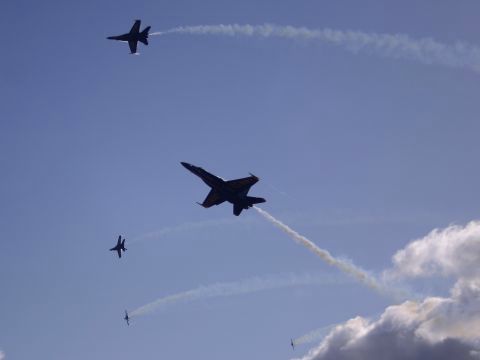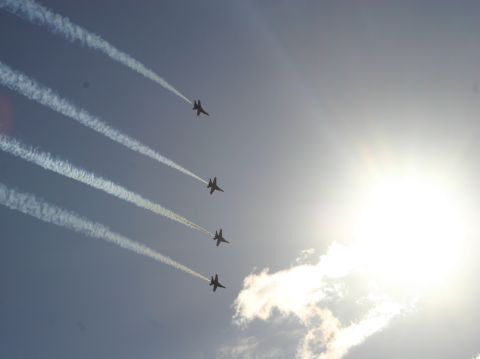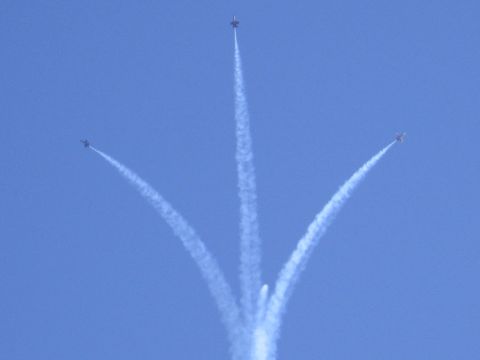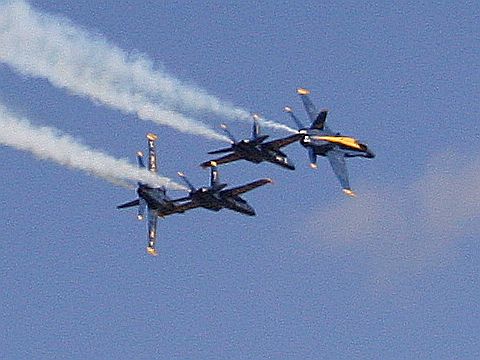Aviation
Aerial Simulated Explosion
As I watched the news today, I saw part of the dedication of the U.S. Air Force Memorial.The monument itself is a trio of sweeping towers that simulate the arcs of air vehicles in flight. Visit the link to get some perspective of the monument.
At the dedication, the Air Force Thunderbirds flew a “bomb burst” formation in tribute to the design of the monument.
Yesterday, we saw the Blue Angels fly a similar maneuver at MCAS Miramar:

More Blue Angels
Back in town today doing chores. Here’s another nice picture of the aerial performance from yesterday.

Angels in the Sunlight
Well you gotta snap a lot of pictures to get a few good ones. This is one that we liked a lot!
The Blue Angels Precision Demo Team in action!

Miramar Air Show
We took over 800 pictures today at the USMCAS Miramar Air Show. Damsel’s camera is still downloading as I type this. It will take some time to go through them all, so I’m going to throw one of them up real quick to get a post on for today. This is the Blue Angels at the top of one of their spectacular maneuvers.

So, what did you do today?
A Historical Look at Torrance Airport
 Sunday, Damsel and I attended a book signing in the old Torrance Library, now the Torrance Historical Society Museum, in Downtown Torrance, California. The book we were having signed is Images in Aviation — Torrance Airport written by my long-time friend and former colleague, Chuck Lobb. We enjoyed a nice visit with Chuck and were happy to see him doing well with his book.
Sunday, Damsel and I attended a book signing in the old Torrance Library, now the Torrance Historical Society Museum, in Downtown Torrance, California. The book we were having signed is Images in Aviation — Torrance Airport written by my long-time friend and former colleague, Chuck Lobb. We enjoyed a nice visit with Chuck and were happy to see him doing well with his book.
Image: Chuck holding the book he signed for us. Photo Credit: Damsel
I just started reading the book today, and as a long-time flyer in the Southern California area, I look forward to learning all about the airport’s history.
Amazon link to Torrance Airport book.
Book Description
Californians were panicked by the Pearl Harbor attack of December 7, 1941, and civilian flights within 200 miles of the coast were immediately terminated. Airfields were commandeered and new ones hastily built. One of these was the Lomita Flight Strip, known today as Zamperini Field, the Torrance Municipal Airport, or TOA. This 490-acre parcel sent four squadrons of P-38 fighter pilots off to war with one commanded by the judge of the Charles Manson trial, an ex-Flying Tiger. Six other pilots became generals, two became commandants of cadets at the Air Force Academy, and one became the only fighter pilot with combat victories in both World War II and the Vietnam War. Japanese Americans returning from World War II internment camps found temporary housing at the field, and the world’s largest manufacturer of civilian helicopters settled there in 1973. The first runway takeoff of a Vertical Take-Off and Landing (VTOL) aircraft was pioneered at TOA, and aerobatic champ Bob Herendeen trained at the site.
About the Author
Charles Lobb is a Federal Aviation Administration certified flight instructor and unofficial historian for Zamperini Field, the Torrance Municipal Airport. Over a 10-year period, he has combed through federal archives and private collections for vintage and compelling photographs, many published here for the first time.
Island Express
Every year, Damsel and I make the pilgrimage back to the place where we got married — Avalon, Santa Catalina Island, California. You might have seen our postings on some of the things we saw this visit.
Crossing the Catalina Channel from San Pedro to Avalon on the Catalina Express boat takes about an hour and fifteen minutes. Crossing the Catalina Channel on the Island Express helicopter takes about fifteen minutes. Always anxious to get there, Damsel and I generally take the helicopter over and the boat back. This works to our advantage two ways: one, we get there quick and start our vacation activities an hour sooner, and two, there is not a restrictive weight limit on the boat for baggage (25 lbs max on the helicopter), and if we buy souvenirs and stuff there, taking the boat back makes sense to us. Actually, both means of transportation are fine with us, and both are enjoyable. This little two-minute movie shows a few sequences I recorded our last trip over.

